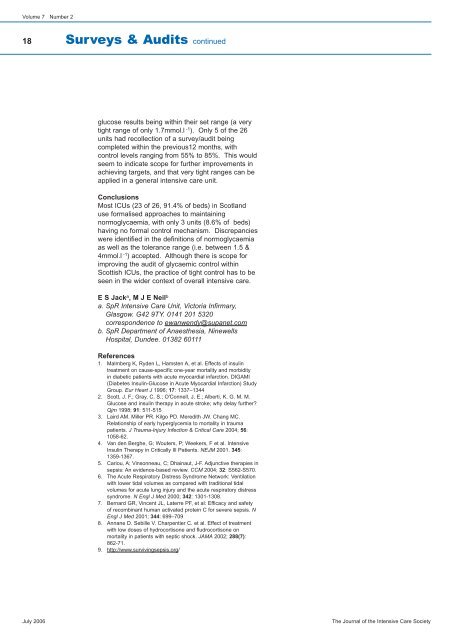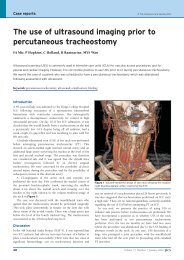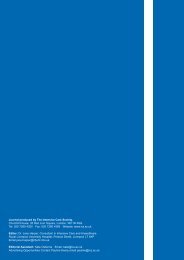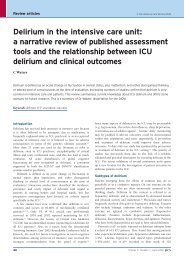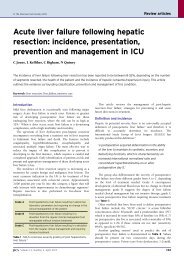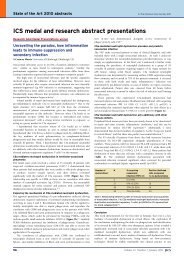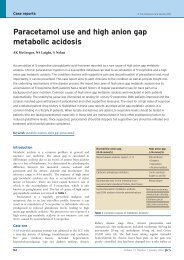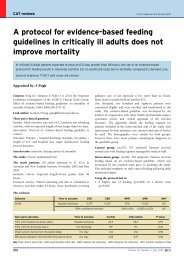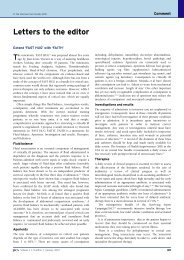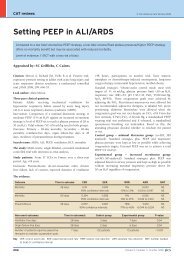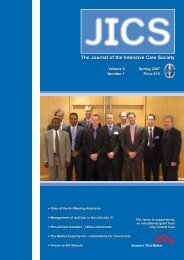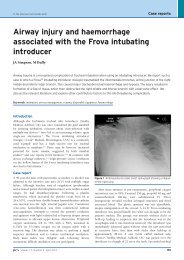Volume 7 Number 2 July 2006 - JICS - The Intensive Care Society
Volume 7 Number 2 July 2006 - JICS - The Intensive Care Society
Volume 7 Number 2 July 2006 - JICS - The Intensive Care Society
Create successful ePaper yourself
Turn your PDF publications into a flip-book with our unique Google optimized e-Paper software.
<strong>Volume</strong> 7 <strong>Number</strong> 2<br />
18<br />
Surveys & Audits continued<br />
glucose results being within their set range (a very<br />
tight range of only 1.7mmol.l -1 ). Only 5 of the 26<br />
units had recollection of a survey/audit being<br />
completed within the previous12 months, with<br />
control levels ranging from 55% to 85%. This would<br />
seem to indicate scope for further improvements in<br />
achieving targets, and that very tight ranges can be<br />
applied in a general intensive care unit.<br />
Conclusions<br />
Most ICUs (23 of 26, 91.4% of beds) in Scotland<br />
use formalised approaches to maintaining<br />
normoglycaemia, with only 3 units (8.6% of beds)<br />
having no formal control mechanism. Discrepancies<br />
were identified in the definitions of normoglycaemia<br />
as well as the tolerance range (i.e. between 1.5 &<br />
4mmol.l -1 ) accepted. Although there is scope for<br />
improving the audit of glycaemic control within<br />
Scottish ICUs, the practice of tight control has to be<br />
seen in the wider context of overall intensive care.<br />
E S Jack a , M J E Neil b<br />
a. SpR <strong>Intensive</strong> <strong>Care</strong> Unit, Victoria Infirmary,<br />
Glasgow. G42 9TY. 0141 201 5320<br />
correspondence to ewanwendy@supanet.com<br />
b. SpR Department of Anaesthesia, Ninewells<br />
Hospital, Dundee. 01382 60111<br />
References<br />
1. Malmberg K, Ryden L, Hamsten A, et al. Effects of insulin<br />
treatment on cause-specific one-year mortality and morbidity<br />
in diabetic patients with acute myocardial infarction. DIGAMI<br />
(Diabetes Insulin-Glucose in Acute Myocardial Infarction) Study<br />
Group. Eur Heart J 1996; 17: 1337–1344<br />
2. Scott, J. F.; Gray, C. S.; O'Connell, J. E.; Alberti, K. G. M. M.<br />
Glucose and insulin therapy in acute stroke; why delay further?<br />
Qjm 1998; 91: 511-515<br />
3. Laird AM. Miller PR. Kilgo PD. Meredith JW. Chang MC.<br />
Relationship of early hyperglycemia to mortality in trauma<br />
patients. J Trauma-Injury Infection & Critical <strong>Care</strong> 2004; 56:<br />
1058-62.<br />
4. Van den Berghe, G; Wouters, P; Weekers, F et al. <strong>Intensive</strong><br />
Insulin <strong>The</strong>rapy in Critically Ill Patients. NEJM 2001. 345:<br />
1359-1367.<br />
5. Cariou, A; Vinsonneau, C; Dhainaut, J-F. Adjunctive therapies in<br />
sepsis: An evidence-based review. CCM 2004; 32: S562-S570.<br />
6. <strong>The</strong> Acute Respiratory Distress Syndrome Network: Ventilation<br />
with lower tidal volumes as compared with traditional tidal<br />
volumes for acute lung injury and the acute respiratory distress<br />
syndrome. N Engl J Med 2000; 342: 1301-1308.<br />
7. Bernard GR, Vincent JL, Laterre PF, et al: Efficacy and safety<br />
of recombinant human activated protein C for severe sepsis. N<br />
Engl J Med 2001; 344: 699–709<br />
8. Annane D. Sebille V. Charpentier C. et al. Effect of treatment<br />
with low doses of hydrocortisone and fludrocortisone on<br />
mortality in patients with septic shock. JAMA 2002; 288(7):<br />
862-71.<br />
9. http://www.survivingsepsis.org/<br />
<strong>July</strong> <strong>2006</strong><br />
<strong>The</strong> Journal of the <strong>Intensive</strong> <strong>Care</strong> <strong>Society</strong>


